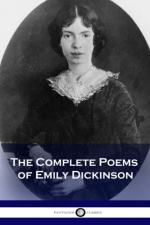|
This section contains 396 words (approx. 1 page at 400 words per page) |

|
Carriage
The “Carriage” (3) symbolizes the human body’s passage from life to death. This journey requires multiple actors: “Death” (1) personified as a gentleman, “Horses” (23) that drive the carriage “toward Eternity” (24), and “Immortality” (4) who rides in the carriage with Death and the dying speaker as a type of chaperone. By depicting dying as a carriage ride, Dickinson highlights its normality and hints that we need not fear it, but she also explores its consequences. The carriage offers no protection to keep the speaker’s dying body from growing cold, but it does effectively enclose and separate her from human society and even the natural world, which passes by outside. By not describing the ending of the carriage ride, the poem suggests that the journey to the afterlife is an eternal one.
House
The barrow-like house symbolizes the grave or presumed final resting place for the speaker. That it...
|
This section contains 396 words (approx. 1 page at 400 words per page) |

|




